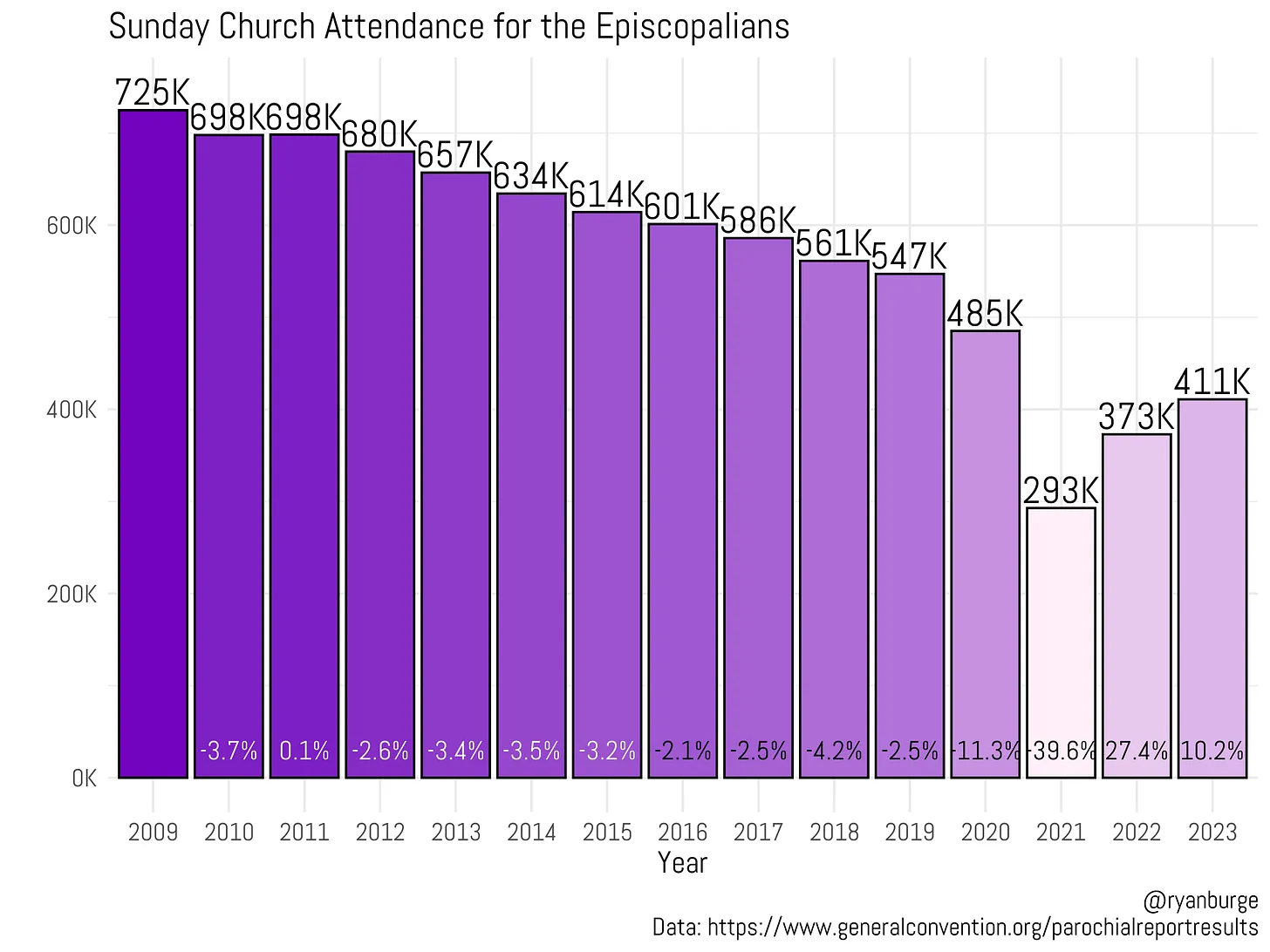Rector's Rambling - October 16, 2025

For those of you who missed last night’s presentation by Dr. Ryan Burge, it was an insightful and enjoyable evening of statistics and analysis. Yep, you heard that right. Statistics were somehow…enjoyable? Even though much of what those statistics portend is negative from the church’s perspective. Yep, that’s true, too, as far as I’m concerned. While I don’t think things are magically or divinely going to turn around and be fine all of a sudden, I think seeing the truth on the screen was helpful. It should disturb us, not to dismay, but to action and renewed mission.
Dr. Burge shared a synopsis of the data that undergirds his new book, which will be published in January 2026. In the book, he will explore what he calls “The hollowing out of moderate congregations,” namely the mainline, and why the decline of these churches is bad for all of us. Last night, he showed us how the share of the country that attends a mainline church has declined from nearly half to closer to ten percent. This has happened for many reasons, but one of them is that our partisan affiliations have driven our church behavior and choices rather than the other way around.
Over time, churches in many places are increasingly becoming polarized. In most denominations, you can now make a pretty good bet about how people voted based on the church they attend. Although the mainline has always been more conservative than liberal, and although mainline churches are labeled as liberal by some in Christendom, the truth is that the mainline still leans conservative, or is at least split down the middle (apart from us Episcopalians, who are increasingly liberal, yet also still mixed). We’ve discussed straight-up demographic issues that feed decline, such as Episcopalians having fewer children per capita than other traditions. However, the other dynamic is the partisan sorting throughout our culture and its impact on church choice.
Dr. Burge’s thesis is that the mainline had long been the place in our larger society where diverse groups (admittedly excluding racial diversity) gathered regularly. Research showed a long time ago that spending time with people who think differently breeds understanding and cooperation. The less we mix with people who are, or at least think differently, means a natural retreat from understanding and unity. The churches that historically straddled the middle (Episcopalians, Lutherans, Methodists, Presbyterians, American Baptists, etc.) have seen people self-select towards options that align better with the partisan winds that blow increasingly stronger. Our strength has also been our weakness, according to Dr. Burge: we weren’t leaning either way strongly enough to retain folks looking for a more polar fit.
That may seem to be a weakness from the standpoint of attendance and longevity to the denominations; however, the fact that we can still stand in the middle is very much a strength and a gift to the broader culture. When the centrist denominations are gone, there will be dramatic and irreconcilable differences in the church, speeding up the deconstructing forces of polarization. So yeah, not great news. But for all that the long-term trends are still worrying, Dr. Burge admitted that Episcopalians have bucked a few trends in recent years. In response to a question from the Rector, he acknowledged that our decline had slowed significantly and noted that our post-pandemic growth is very good by mainline church standards. For example, our average Sunday attendance is up 40% from the low after the pandemic. That doesn’t sound great, but let’s look at the Evangelical Lutheran Church of America (ELCA), our closest sibling in the mainline.
Their post-pandemic growth from the pandemic low has only been 22%. Our declines due to the pandemic are also different. We saw attendance fall by 39% from 2019 to 2020. ELCA’s dropped by 51% in the same time. They lost a greater percentage of their attendance and have seen a lower return than ours. And, as I noted last month, we have seen a bump in the number of our younger members, which again, sets us apart from almost all of the mainline (especially the ones most like us: Methodists, Presbyterians, and Lutherans). Yeah, the ship is still sinking, so to speak, but God is up to something. I’ve said it before, and it bears repeating: the church isn’t dying, it’s changing. The ways in which it is changing are not anyone’s “fault,” although many people seem to want to lay blame. Playing the blame game is a losing proposition.
Our hope, as it turns out, is that we are precisely what the world, and more specifically, our nation needs right now: an institution that still welcomes anyone who wants to be here, where we can worship and work alongside folks who are different from us and thereby more challenging to hate (or strongly dislike, anyway…). We can continue to proclaim God’s love and bonds of affection that draw us together despite our tendency to want to pull apart. We don’t just preach it, we live it. We don’t have to fix the world; we just have to be faithful and let God handle the rest. Statistics are great and interesting, but they will never tell the whole story, ours or God’s.


